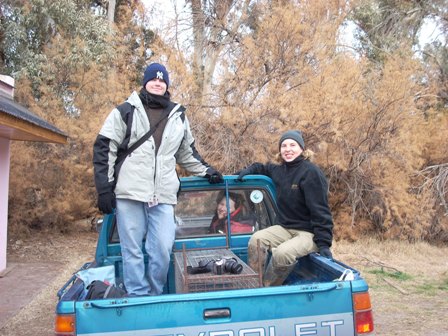| (later) 13 July 2007 The Pampas Cat! |
| On our very first night at Los Alamos we got to see something amazing! We saw a pampas cat in the wild! This is one of the most rarely seen cats in the world! Very little is known about it because it is so difficult to find, catch, and study. We were doing what is called a nocternal transect. Basically all ten of us pile into the pick-up truck-- some in the cab, some in the back-- and we drive at 15 km/h along different routes thoughout the study area. As we drive, a giant spotlight is used to search the grassland, trees, brush, road, etc for the flash of light that is the spotlight reflected in the eyes of an animal. We saw the glowing eyes of a cat, and at first everyone thought it was just a domestic cat. But, when we got closer, we discovered that it was a pampas cat! It was in the field a short way away from the road, and it let us walk very close and take pictures. After maybe 10 minutes or so, it finally ran away down the road. We were all very excited about how lucky we were on our very first night! Claudia, Diego, Miriam, and Ariane were ecstatic. This was the first time that they had seen a pampas cat in the wild. Claudia kept saying how unbelievable it was-- "This just doesn't happen!" It was a very exciting first night. |
| The Pampas Cat! |
| 14 July 2007 Setting the Boxtraps |
| One part of our study environment... why GPS is useful |
| For me, it's crazy to think that this is July. July is "supposed to be" hot summer weather. Here in Argentina I'm sleeping in long underwear and heavy sweatshirts. This morning I put on 2 layers of pants, a longsleeve shirt, a big wool sweater, and a giant fleece. It is cold- much colder than I expected, especially as we bounce around in the back of the truck. Just a few days ago, on July 10, Buenos Aires got the first snow they've seen since 1918, so it is even colder than normal. I picture my friends at home on the beach as I try to feel my numb fingers... I'd still rather be here! |
| Today we went out to set traps. The goal of this project is to learn as much as possible about the different species of cats that live in this environment. One way to do this is to use traps to catch individuals that can be measured, photographed, tagged, released, and then tracked with radio telemetry. We set five of the 13 traps today. The traps are spaced out but in the same general area. All of the trap locations are programmed into the GPS. If they weren't I don't know how you'd ever find them again-- this grassland seems to go on forever, and it looks the same in every direction. We never go out into the field without the GPS--it's a very helpful tool to have! The ground here is surprisingly sandy. In the sand grows the pampas grasses and small very-thorny shrubs. As we navigate through this vegetation, we continuously stumble on mounds made by sand dune tuco-tucos (a very vocal rodent) and holes made by skunk, armadillos, and who knows what else. |
| Mastering the GPS |
| The traps we set are a combo box trap/leg traps. The box traps have 2 sections: The bait (either a live chicken or raw chicken meat/heart/gizzard) is placed in one section where the cat can never actually get it. The other end of the trap is open. When a cat enters the trap on its way to try and get the bait, it steps on a trigger that closes & lockes the door. Around the outside of the box traps, we also set a series of leg traps. If the cat goes for the bait without entering the box trap, it will get caught in a leg trap. Once traps are set, they must be checked every 6 hours. The well-being of the animals is the most important thing so we want to make sure that any trapped animal is released as soon as possilbe. |
| Setting the boxtraps |
| Alex (Kath in the window) & Me, bundled up and ready to go! |
| Good luck, chicken! Thanks for your help! |






